As humans, we tend to focus more on the things we need to do than the things we’ve already done. This so-called “Zeigarnik effect”, named after Russian psychologist Bluma Zeigarnik, means our minds are often swimming with all of the tasks, responsibilities, and mental notes that we think we should be focusing on. That’s where Prioritization Matrix can help!
All of these tasks and projects that need doing, this mental to-do list, without a clear hierarchy of importance can make it difficult for us to stay focused and actually get things done.
One way to combat all of this Zeigarnik noise is to note down everything. Make an actual to-do list. Studies have been done, and it has been shown that the very act of noting down tasks can quite simply “make you more effective”.
But, even with a to-do list, before you actually get anything done it’s necessary to have a clear idea of your priorities.
Sounds simple enough, right? Unfortunately, figuring out what to prioritize can be hard. It’s a complicated process that involves weighing up cost against value, effort against time, and for a lot of businesses, will likely involve many different stakeholders.
The solution is to work out a process for determining what to prioritize.
Having a clear process for lining up your tasks or projects, and deciding which of them you should prioritize right now, can save you from wasting time deliberating on less important things.
In this article we’ll be looking at one of the many techniques for sorting out your priorities – the prioritization matrix. I’ll break down the basic idea, and run through a few different approaches for building your own prioritization matrix. There’s even a free premade checklist template you can use to guide you through the whole process.
The concept of a prioritization matrix was popularized by authors Michael Brassard (The Memory Jogger 2) and David Allen (Getting Things Done).
I’m sure you’re keen to see the actual template, so here’s a quick link:
You can click here to get the prioritization matrix template.
Now, let’s start with the basics.
What is a prioritization matrix?
A prioritization matrix is a business process analysis tool, often used alongside other bpm software or Six Sigma techniques for comparing choices using specific criteria, and figuring out what to prioritize.
It can be applied to anything, from simple tasks to complex projects, by anyone, from single individuals to large organizations.
A prioritization matrix provides stakeholders with a reliable process for resolving disagreements, and deciding on which proposals to focus on. They also help to weed out disingenuous incentives and hidden agendas, in the case of project prioritization, by promoting consensus.
There are multiple forms a prioritization matrix can take, based on complexity of criteria for assessing priorities, as well as what those specific criteria are defined as.
For example, some matrices are simple 2×2 grids with “cost” plotted against “value”, like this:
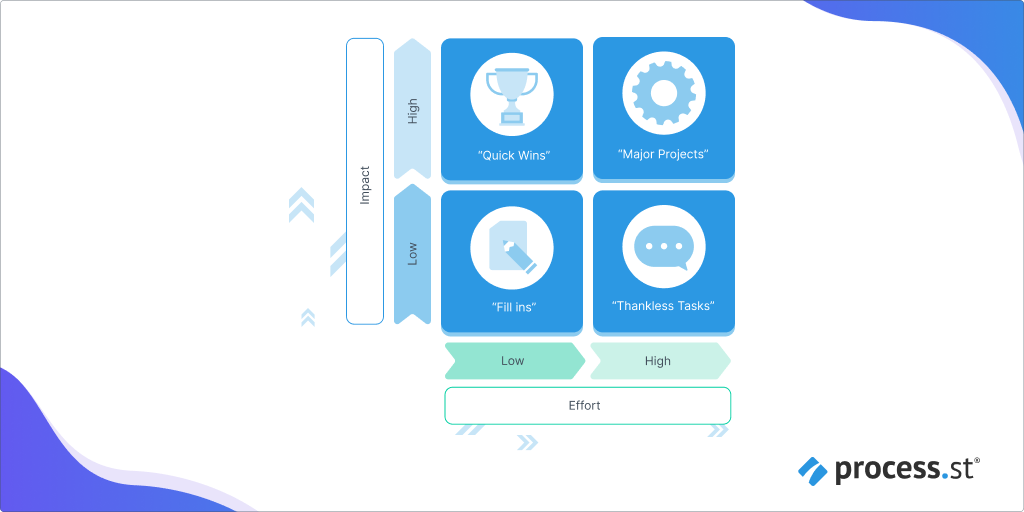
Others, like those used in the Six Sigma methodology, are more complicated and require a more thorough approach to design and application.
Prioritization matrix for Six Sigma
A prioritization matrix can also refer to a specific Six Sigma technique for continuous improvement. It is one of the seven management tools used in the Six Sigma methodology.
In this context, a prioritization matrix is a visual diagram used to compare multiple (at least two) sets of data using weighted criteria.
Project prioritization is critical to the overall quality improvement process in Six Sigma. Here, prioritization matrices are practical tools used in the planning and analysis phases of various continuous improvement methodologies like DMAIC and PDSA.
These matrices are often more complex, like this cause-and-effect matrix for calculating Six Sigma input (X) and output (Y) priorities:
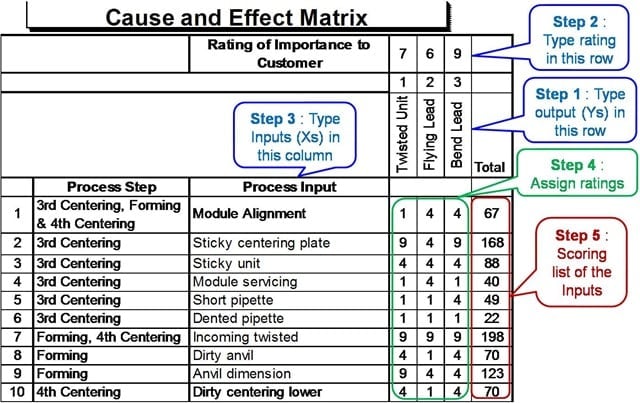
3 types of priority matrix
Within Six Sigma, there are at least three different types of prioritization matrices, as defined by Lynne Hambleton in Treasure Chest of Six Sigma Growth Methods, Tools, and Best Practices: A Desk Reference Book for Innovation and Growth:
- Full analytical criteria
- Consensus criteria
- Combination matrix
Full analytical criteria
This method is by far the most complex type of prioritization matrix, as it involves using multiple matrices to compare different pairs of options before a final matrix is produced.
It is best reserved for your most important decisions, and works best with smaller teams (three to eight people) due to the nature of a wider scope making it harder to reach consensus with more people involved.
Consensus criteria
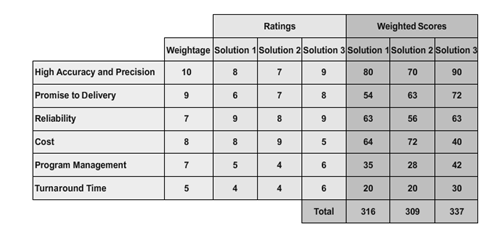
When all your options appear to be roughly equal, this method is a simplified version of the full analytical criteria.
It also uses weighted voting, where a number value is given to each option to rank priority.
Works best with fewer (less than 10) items and criteria, in order to keep things simple.
Combination matrix
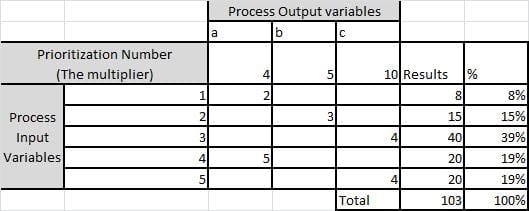
For prioritizing options based on a cause-and-effect relationship, use a combination matrix.
Unlike the other methods, which are based on criteria, the combination matrix is causal-based, which means you’ll need an experienced team with in-depth knowledge of the process you’re optimizing your priorities for.
This method uses L-shaped diagrams to show critical relationships between two or more groups, in combination with a tree diagram to depict hierarchy of tasks.
I’ll be looking more closely at the consensus matrix later on in the post, after going over a more simplistic method.
Simple or complex, matrices are shaped by the criteria they use to define priorities, and how your matrix will look largely depends on what you are trying to prioritize.
The point is, a prioritization matrix has one goal: to sort your options in order of importance. Whatever type of matrix you’re using, the process used is pretty much the same.
Benefits of using a prioritization matrix
In principle, the benefits of a prioritization matrix are quite straightforward. In support of structured decision-making, they make it easy to:
- Break down and prioritize complex issues when there are multiple factors influencing the decision
- Objectively and unambiguously rank your priorities
- Determine most crucial focus areas
- Establish a basis for discussion about what is important
- Garner team/stakeholder support for important buy-ins
In the following section, I’ll run through the steps for a simple 2×2 grid matrix, and afterwards go on to explore how to use a more complicated matrix with weighted criteria.
Simple prioritization matrix (5 steps)
In its simplest form, it’s a 2×2 grid that plots simple, direct concepts like “urgency” and “importance”.
This kind of matrix is great for prioritizing small business tasks, and is a basic yet reliable process for making sure you’re dealing with your to-do list in the most efficient manner possible.
Step 0: List your tasks
You may or may not have already done this, but the first step for any prioritization matrix is to make a list of all of your tasks, or whatever it is you’re trying to prioritize.
Step 1: What are the consequences?
Ask yourself what might be the consequences for not doing each of your tasks, or more generally, not prioritizing a certain option.
Step 2: What’s important?
Split your list into two categories: high and low importance. Then, considering all consequences you listed in the previous step, place each of your options into the category you deem most fit.
Step 3: What’s urgent?
Now, for all “high importance” and “low importance” options, split each into a further sub-category of “high urgency” and “low urgency”. You should now have four groups in total.
Step 4: Assign number values
Now, assign number values 1 to 4 to each of your options, where a lower number means a higher priority.
Like so:
- High importance and high urgency: 1
- High importance and low urgency: 2
- Low importance and high urgency: 3
- Low importance and low urgency: 4
This quick, simple method can help you cut through mental noise and start getting things done with basically zero setup time.
If you want to know how to apply a more advanced prioritization matrix, then read on.
How to use a prioritization matrix
Whatever the matrix, the procedure starts with making a list of all of your (unsorted) priorities, and ends with that same list ordered by some quantifiable metric.
Here, we’ll look at the process for using a consensus criteria matrix, one of the three main matrices used in Six Sigma.
This process is best performed with a small group (less than 10 people).
That process can be broken down into five simple steps.
0. Orient your team
Before doing anything else, you must clearly explain the purpose for constructing the prioritization matrix.
This will involve going over the context of company goals, as well as current strengths and weaknesses the business currently faces.
Now is also when you should make sure everyone involved in the process agrees on the options (solutions, projects, or whatever) that need to be prioritized.
In order to facilitate this kind of communication of context of the organization, you may want to consider performing a SWOT or FMEA analysis, and presenting the results to your team.
1. Determine your criteria
Once your team is prepped, and you have a clear idea of what options you’ll be prioritizing, it’s time to set out the criteria for assessing importance.
This can be broken into two parts:
- The actual criteria
- A rating scale with which to assess importance
You and your team should focus on criteria that clearly differentiates important from unimportant options. Aim for around five to ten different criteria.
You want to have enough criteria to reasonably discern your priorities, but not too much that consensus becomes difficult.
For example, you may include criteria such as:
- How much value a certain option offers the customer
- Whether or not it is of regulatory importance
- Long-term versus short-term impact
When deciding the rating scale, it’s important to base the scale on some concrete reference point that everyone will clearly grasp. The table below illustrates this nicely, in the right column:
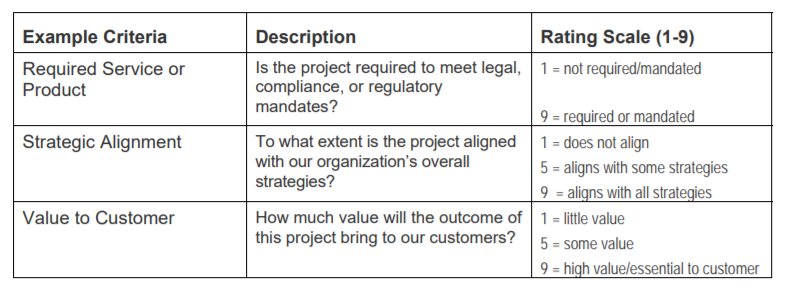
2. Give each of your criteria a weighted value
Next, place your criteria in descending order of importance, with the most important option at the top, and give each of your criteria a weighted value.
Make sure this weighting is agreed on by everyone involved.
To extend the example used above, you might choose to give the following weighted values:
Required Service or Product: Weight = 5
Strategic Alignment: Weight = 4
Value to Customer: Weight = 4
This weighted value represents the relative importance of each criterion, and will be used to calculate the final score.
3. Prepare the matrix
Make a list of your criteria on the left, with the weight, scoring values, and options across the top, like so:
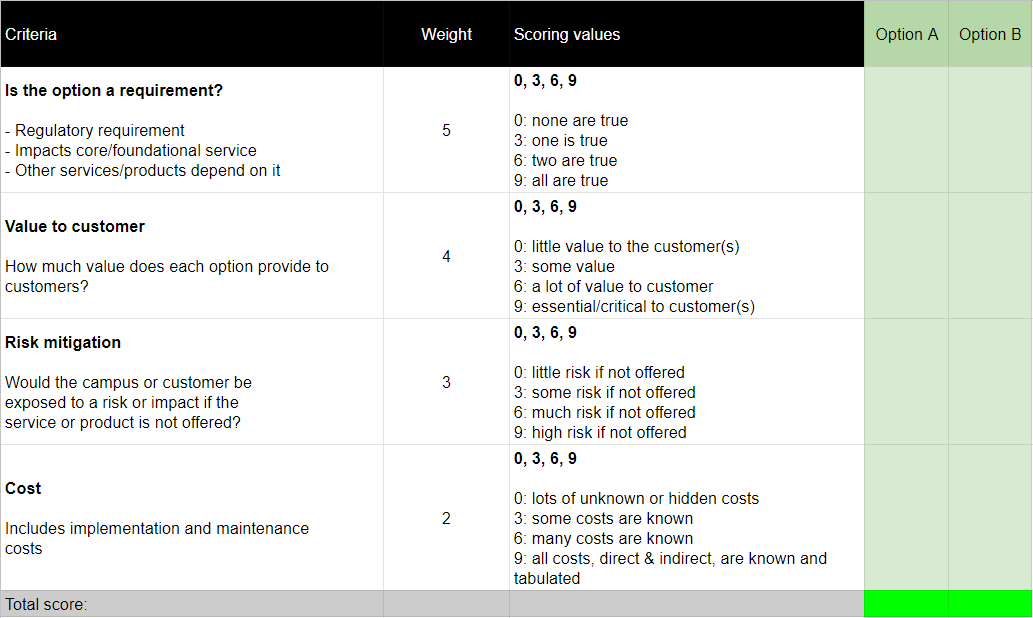
Fill in all the remaining details, and you’ll be ready to score your table.
4. Score each option
Review each option against all criteria, and decide what score you think is adequate. Don’t record this value in the right-hand column just yet, because you still need to calculate the weights.
If possible, it is helpful to determine scores together in teams, rather than alone. This will facilitate consensus and help alleviate bias. Ideally, you want to evaluate each option by two different teams, and average the results.
By working in teams, you benefit from:
- More objective, reliable results
- If you have a large number of options to review, splitting the workload over a team of people can improve efficiency and speed things up
- Multiple teams scoring the same option means you can gain insight into how well your criteria has been defined, and whether or not everyone in your organization truly understands the purpose of the exercise to the same level
- Consistency and efficacy of the rating scale can more accurately be determined
During the scoring process (but ideally before, in the orientation stage) providing your team with resources like strategic plans and company policies will help to make sure your team members are able to make a properly informed evaluation.
5. Calculate weighted scores for each option
Once you’ve decided on the scoring, multiply the corresponding score with the weight value of each criterion and record the value in the right column.
Finally, add all values for each option and record the cumulative score in the bottom row.
The options are then ranked in order of priority based on their total score.
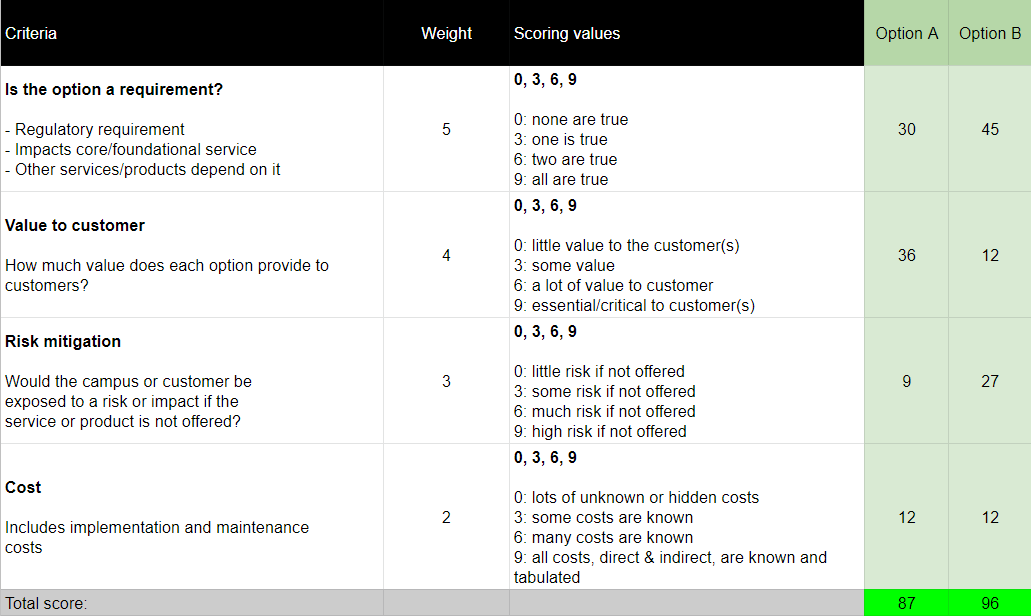
6. Compare your results with your team
Everyone should have scored their options and have a preliminary list of ordered priorities.
Now it’s time to have an open discussion with your team, where you can compare and consolidate notes to create a master list that everyone agrees upon.
If there is disagreement within your group, numerically valued ratings allow for quick and easy adjustments. Adjustments should be expected, and fine-tuning the rating system or weighted values should be seen as stages in the cycle of continuous improvement.
Despite best intentions, you must remember that the prioritization matrix is a tool to establish an actionable hierarchy of importance. It is not the be-all, end-all, and priority ranking for each option can (and should) be challenged, regardless of the score it received.
As a final note, it’s a great idea to run the results of the analysis past as many relevant-interested-eyes as possible. Stakeholders, customers, and other employees will be able to give you valuable feedback on the results of your prioritization matrix analysis.
Free prioritization matrix template
This simple (and free!) prioritization matrix template will help simplify the whole process of preparing for and using a prioritization matrix for yourself or your business:
Click here to get the prioritization matrix template
You can use it to streamline every step, from deciding which options to prioritize, to sharing your results with relevant interested parties, and it even creates a simple matrix for you, automatically! Process Street features like conditional logic and dynamic due dates lighten your workload of tedious repetitive tasks.
If you haven’t already, sign up for a free Process Street account today, and get this + tonnes more premade templates to help you with prioritization and business process management.
What’s next?
You’ve got your priorities straight, now it’s time to act on them. The nature of your priorities will determine where you go from here.
What does your number one priority look like? Perhaps it’s a problem with a specific process that needs dealing with, in which case the following table may be useful:
Here are some methodologies for continuous improvement that you could use to tackle your number one priority:
- Design for Six Sigma (DFSS)
- Kaizen
- DMAIC: The Complete Guide to Lean Six Sigma in 5 Key Steps
- The 7 Core Six Sigma Principles to Build Your Business Around
Did you find this article useful? Was there anything you weren’t sure about? Feel free to let us know in the comments below, and we’ll try and help you out in any way we can.







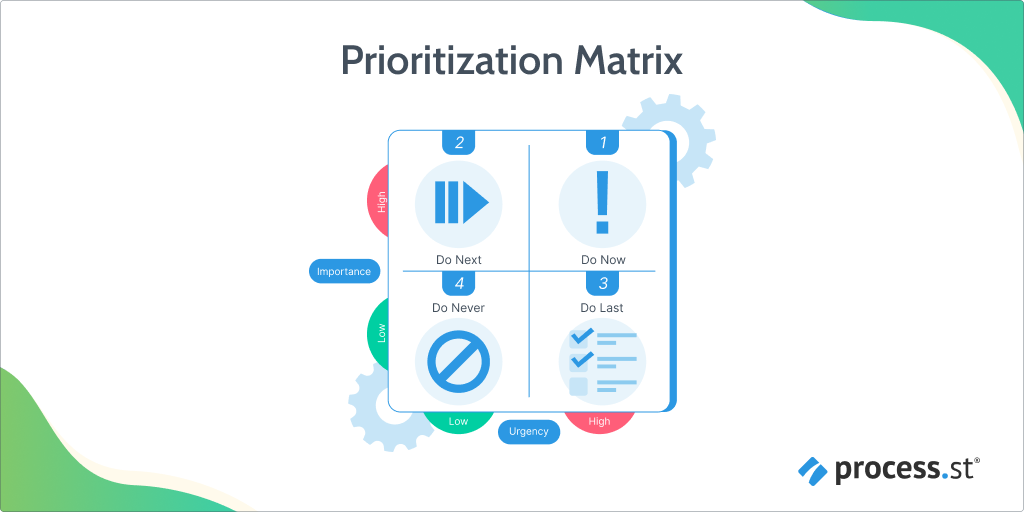
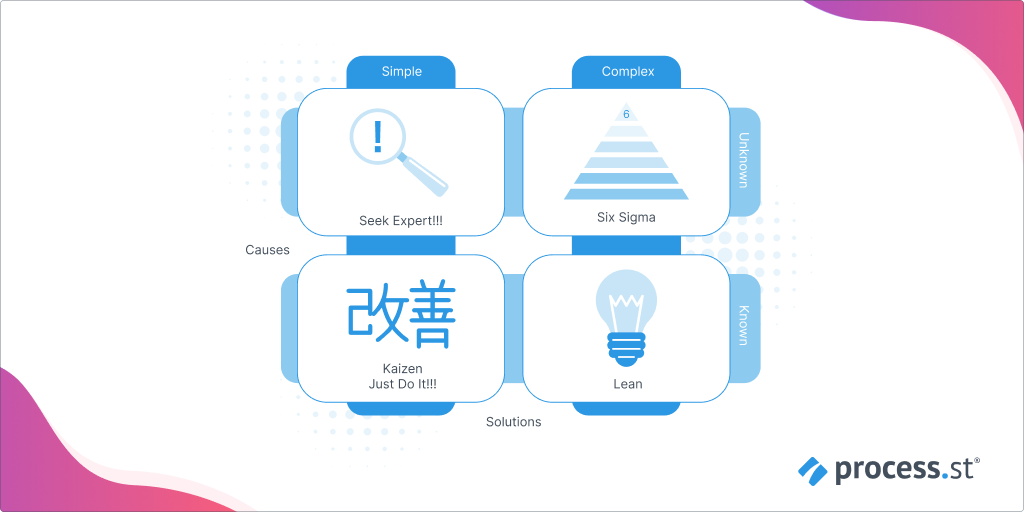

Oliver Peterson
Oliver Peterson is a content writer for Process Street with an interest in systems and processes, attempting to use them as tools for taking apart problems and gaining insight into building robust, lasting solutions.